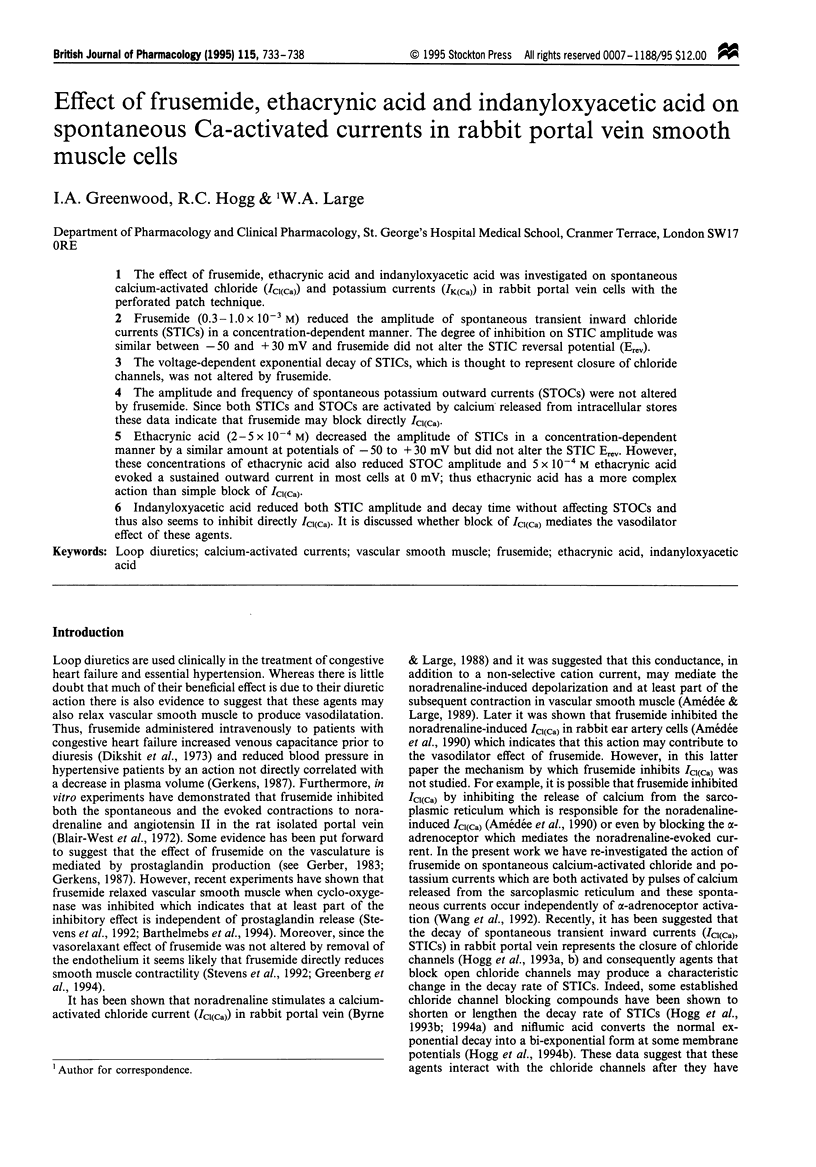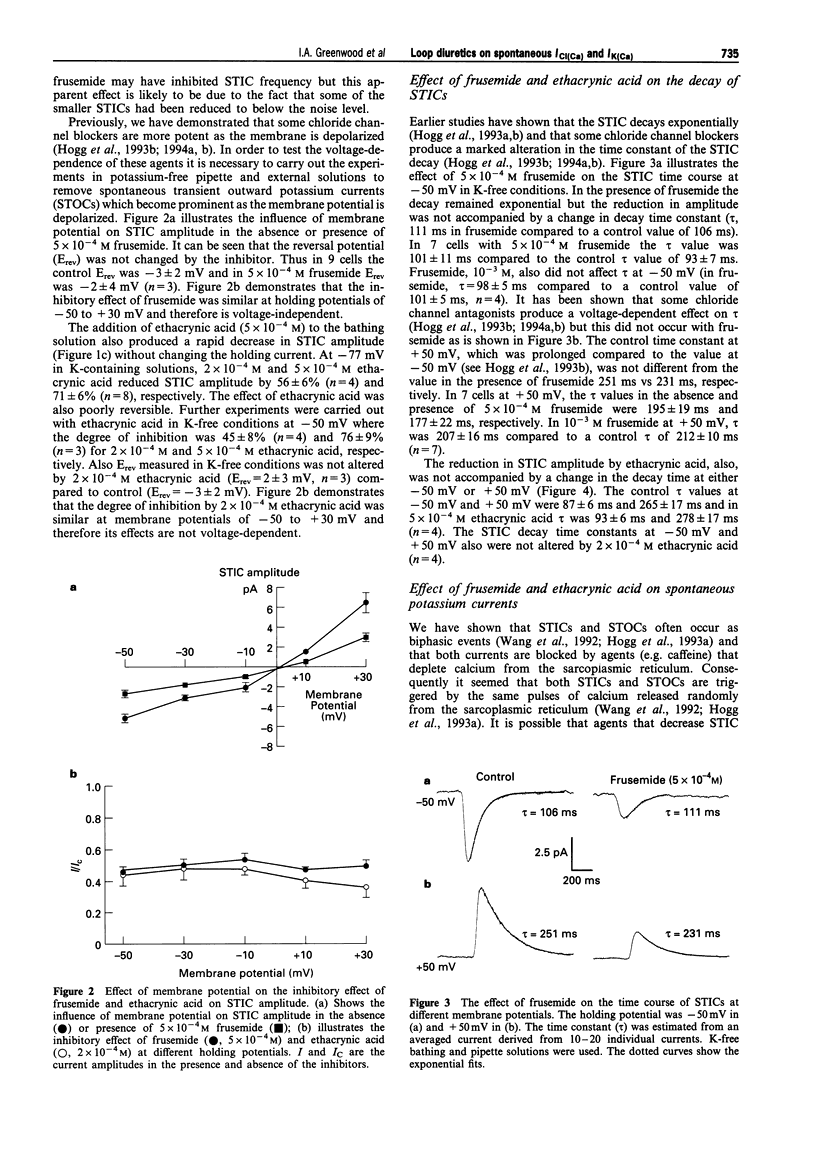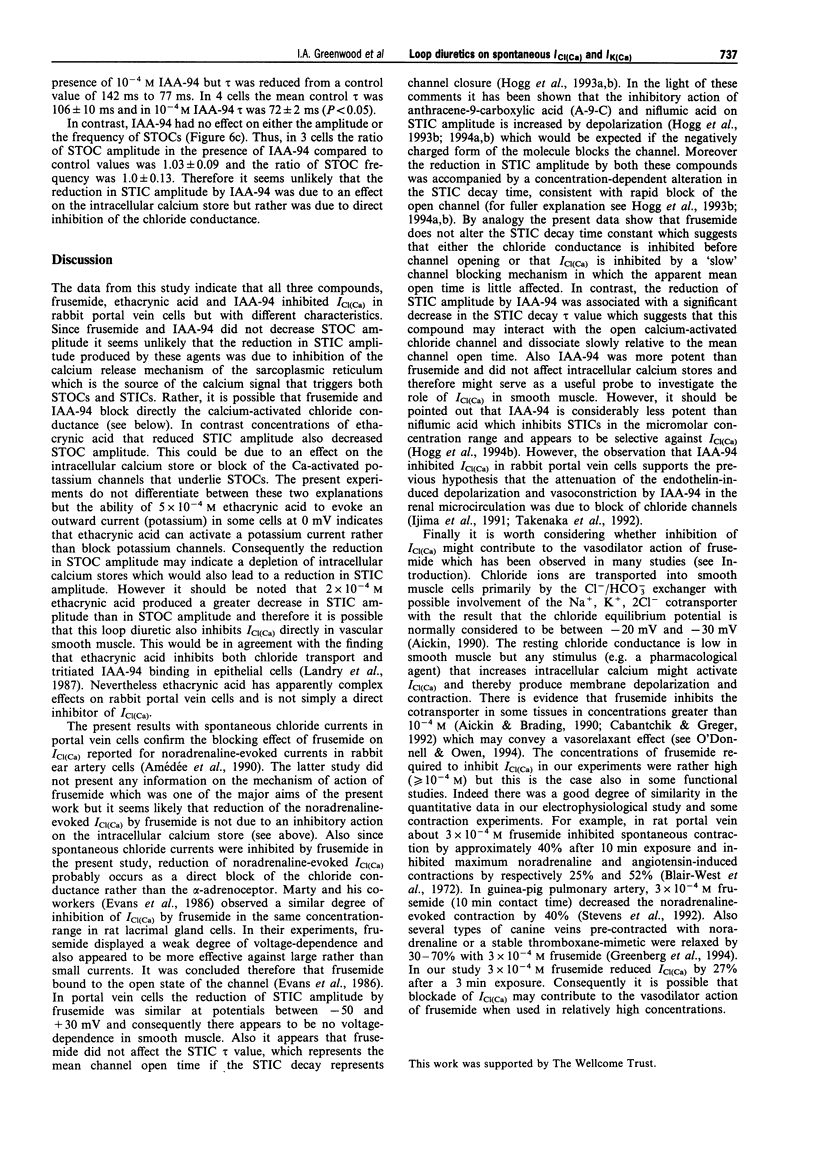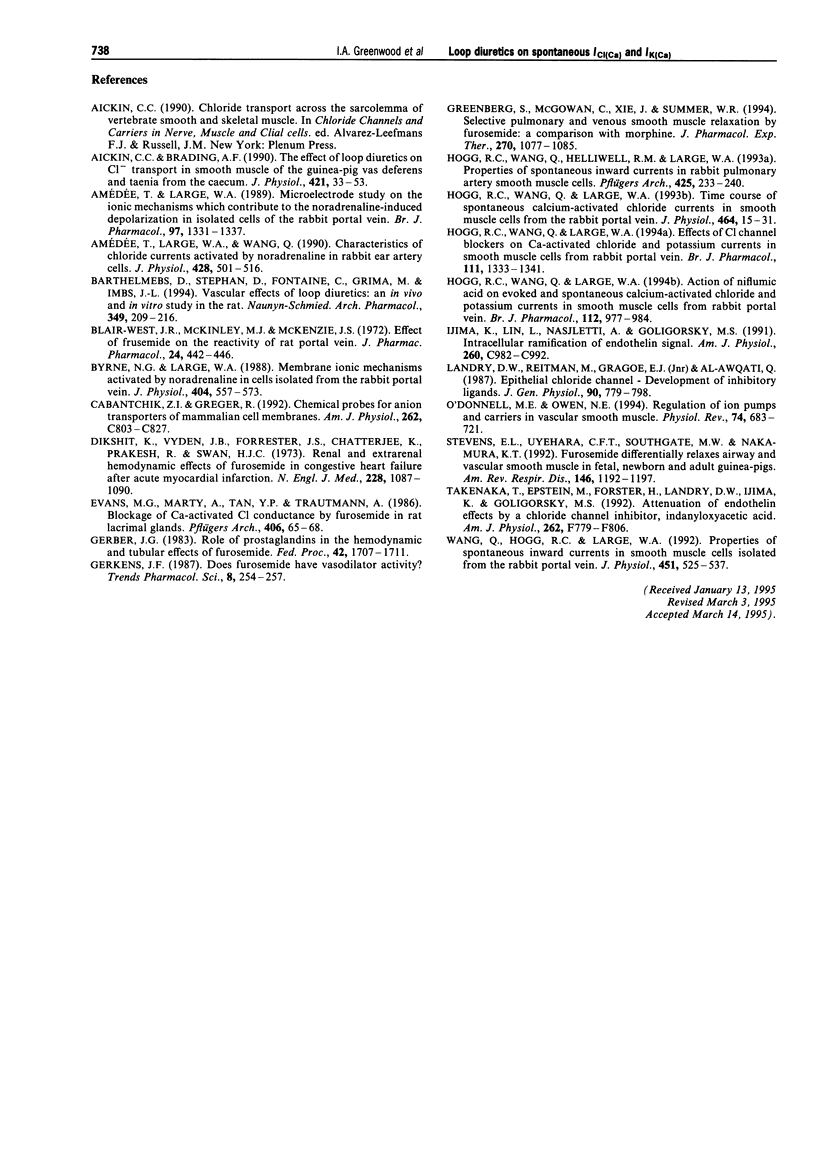Abstract
1. The effect of frusemide, ethacrynic acid and indanyloxyacetic acid was investigated on spontaneous calcium-activated chloride (ICl(Ca)) and potassium currents (IK(Ca)) in rabbit portal vein cells with the perforated patch technique. 2. Frusemide (0.3-1.0 x 10(-3) M) reduced the amplitude of spontaneous transient inward chloride currents (STICs) in a concentration-dependent manner. The degree of inhibition on STIC amplitude was similar between -50 and +30 mV and frusemide did not alter the STIC reversal potential (Erev). 3. The voltage-dependent exponential decay of STICs, which is thought to represent closure of chloride channels, was not altered by frusemide. 4. The amplitude and frequency of spontaneous potassium outward currents (STOCs) were not altered by frusemide. Since both STICs and STOCs are activated by calcium released from intracellular stores these data indicate that frusemide may block directly ICl(Ca). 5. Ethacrynic acid (2-5 x 10(-4) M) decreased the amplitude of STICs in a concentration-dependent manner by a similar amount at potentials of -50 to +30 mV but did not alter the STIC Erev. However, these concentrations of ethacrynic acid also reduced STOC amplitude and 5 x 10(-4) M ethacrynic acid evoked a sustained outward current in most cells at 0 mV; thus ethacrynic acid has a more complex action than simple block of ICl(Ca). 6. Indanyloxyacetic acid reduced both STIC amplitude and decay time without affecting STOCs and thus also seems to inhibit directly ICl(Ca). It is discussed whether block of ICl(Ca) mediates the vasodilator effect of these agents.
Full text
PDF





Selected References
These references are in PubMed. This may not be the complete list of references from this article.
- Aickin C. C., Brading A. F. The effect of loop diuretics on Cl- transport in smooth muscle of the guinea-pig vas deferens and taenia from the caecum. J Physiol. 1990 Feb;421:33–53. doi: 10.1113/jphysiol.1990.sp017932. [DOI] [PMC free article] [PubMed] [Google Scholar]
- Amédée T., Large W. A. Microelectrode study on the ionic mechanisms which contribute to the noradrenaline-induced depolarization in isolated cells of the rabbit portal vein. Br J Pharmacol. 1989 Aug;97(4):1331–1337. doi: 10.1111/j.1476-5381.1989.tb12596.x. [DOI] [PMC free article] [PubMed] [Google Scholar]
- Amédée T., Large W. A., Wang Q. Characteristics of chloride currents activated by noradrenaline in rabbit ear artery cells. J Physiol. 1990 Sep;428:501–516. doi: 10.1113/jphysiol.1990.sp018224. [DOI] [PMC free article] [PubMed] [Google Scholar]
- Barthelmebs M., Stephan D., Fontaine C., Grima M., Imbs J. L. Vascular effects of loop diuretics: an in vivo and in vitro study in the rat. Naunyn Schmiedebergs Arch Pharmacol. 1994 Feb;349(2):209–216. doi: 10.1007/BF00169839. [DOI] [PubMed] [Google Scholar]
- Blair-West J. R., McKinley M. J., McKenzie J. S. Effect of frusemide on the reactivity of rat portal vein. J Pharm Pharmacol. 1972 Jun;24(6):442–446. doi: 10.1111/j.2042-7158.1972.tb09029.x. [DOI] [PubMed] [Google Scholar]
- Byrne N. G., Large W. A. Membrane ionic mechanisms activated by noradrenaline in cells isolated from the rabbit portal vein. J Physiol. 1988 Oct;404:557–573. doi: 10.1113/jphysiol.1988.sp017306. [DOI] [PMC free article] [PubMed] [Google Scholar]
- Cabantchik Z. I., Greger R. Chemical probes for anion transporters of mammalian cell membranes. Am J Physiol. 1992 Apr;262(4 Pt 1):C803–C827. doi: 10.1152/ajpcell.1992.262.4.C803. [DOI] [PubMed] [Google Scholar]
- Dikshit K., Vyden J. K., Forrester J. S., Chatterjee K., Prakash R., Swan H. J. Renal and extrarenal hemodynamic effects of furosemide in congestive heart failure after acute myocardial infarction. N Engl J Med. 1973 May 24;288(21):1087–1090. doi: 10.1056/NEJM197305242882102. [DOI] [PubMed] [Google Scholar]
- Evans M. G., Marty A., Tan Y. P., Trautmann A. Blockage of Ca-activated Cl conductance by furosemide in rat lacrimal glands. Pflugers Arch. 1986 Jan;406(1):65–68. doi: 10.1007/BF00582955. [DOI] [PubMed] [Google Scholar]
- Gerber J. G. Role of prostaglandins in the hemodynamic and tubular effects of furosemide. Fed Proc. 1983 Apr;42(6):1707–1710. [PubMed] [Google Scholar]
- Greenberg S., McGowan C., Xie J., Summer W. R. Selective pulmonary and venous smooth muscle relaxation by furosemide: a comparison with morphine. J Pharmacol Exp Ther. 1994 Sep;270(3):1077–1085. [PubMed] [Google Scholar]
- Hogg R. C., Wang Q., Helliwell R. M., Large W. A. Properties of spontaneous inward currents in rabbit pulmonary artery smooth muscle cells. Pflugers Arch. 1993 Nov;425(3-4):233–240. doi: 10.1007/BF00374172. [DOI] [PubMed] [Google Scholar]
- Hogg R. C., Wang Q., Large W. A. Action of niflumic acid on evoked and spontaneous calcium-activated chloride and potassium currents in smooth muscle cells from rabbit portal vein. Br J Pharmacol. 1994 Jul;112(3):977–984. doi: 10.1111/j.1476-5381.1994.tb13177.x. [DOI] [PMC free article] [PubMed] [Google Scholar]
- Hogg R. C., Wang Q., Large W. A. Effects of Cl channel blockers on Ca-activated chloride and potassium currents in smooth muscle cells from rabbit portal vein. Br J Pharmacol. 1994 Apr;111(4):1333–1341. doi: 10.1111/j.1476-5381.1994.tb14891.x. [DOI] [PMC free article] [PubMed] [Google Scholar]
- Hogg R. C., Wang Q., Large W. A. Time course of spontaneous calcium-activated chloride currents in smooth muscle cells from the rabbit portal vein. J Physiol. 1993 May;464:15–31. doi: 10.1113/jphysiol.1993.sp019622. [DOI] [PMC free article] [PubMed] [Google Scholar]
- Iijima K., Lin L., Nasjletti A., Goligorsky M. S. Intracellular ramification of endothelin signal. Am J Physiol. 1991 May;260(5 Pt 1):C982–C992. doi: 10.1152/ajpcell.1991.260.5.C982. [DOI] [PubMed] [Google Scholar]
- Landry D. W., Reitman M., Cragoe E. J., Jr, Al-Awqati Q. Epithelial chloride channel. Development of inhibitory ligands. J Gen Physiol. 1987 Dec;90(6):779–798. doi: 10.1085/jgp.90.6.779. [DOI] [PMC free article] [PubMed] [Google Scholar]
- O'Donnell M. E., Owen N. E. Regulation of ion pumps and carriers in vascular smooth muscle. Physiol Rev. 1994 Jul;74(3):683–721. doi: 10.1152/physrev.1994.74.3.683. [DOI] [PubMed] [Google Scholar]
- Stevens E. L., Uyehara C. F., Southgate W. M., Nakamura K. T. Furosemide differentially relaxes airway and vascular smooth muscle in fetal, newborn, and adult guinea pigs. Am Rev Respir Dis. 1992 Nov;146(5 Pt 1):1192–1197. doi: 10.1164/ajrccm/146.5_Pt_1.1192. [DOI] [PubMed] [Google Scholar]
- Takenaka T., Epstein M., Forster H., Landry D. W., Iijima K., Goligorsky M. S. Attenuation of endothelin effects by a chloride channel inhibitor, indanyloxyacetic acid. Am J Physiol. 1992 May;262(5 Pt 2):F799–F806. doi: 10.1152/ajprenal.1992.262.5.F799. [DOI] [PubMed] [Google Scholar]
- Wang Q., Hogg R. C., Large W. A. Properties of spontaneous inward currents recorded in smooth muscle cells isolated from the rabbit portal vein. J Physiol. 1992;451:525–537. doi: 10.1113/jphysiol.1992.sp019177. [DOI] [PMC free article] [PubMed] [Google Scholar]


